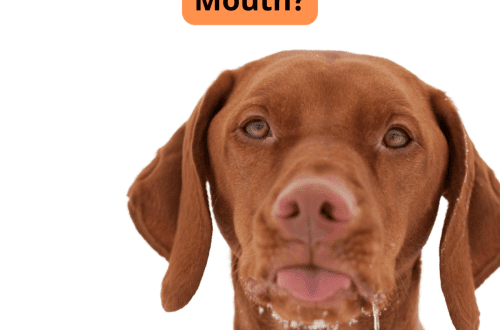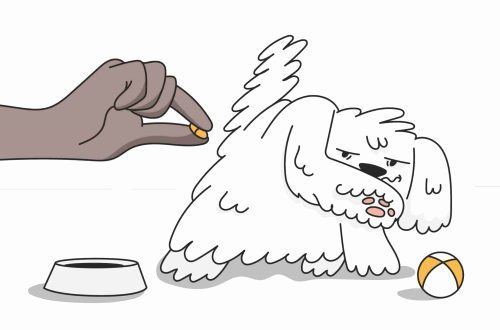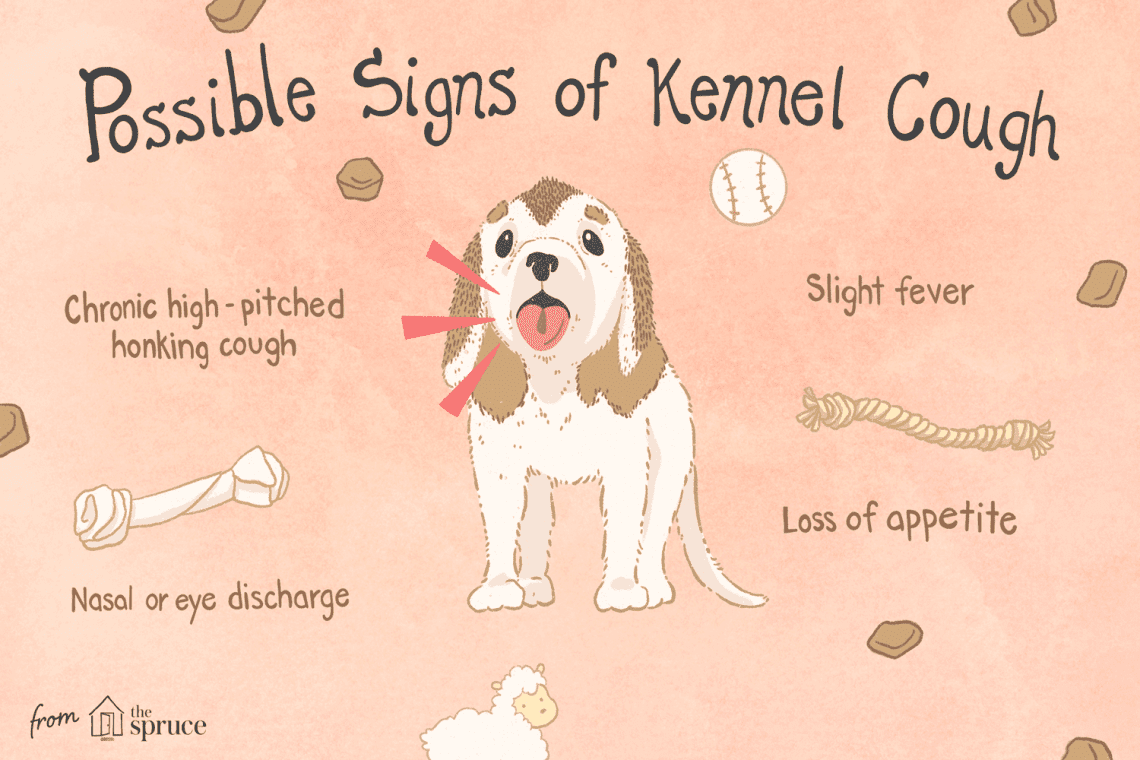
Cough in a dog – causes and how to treat
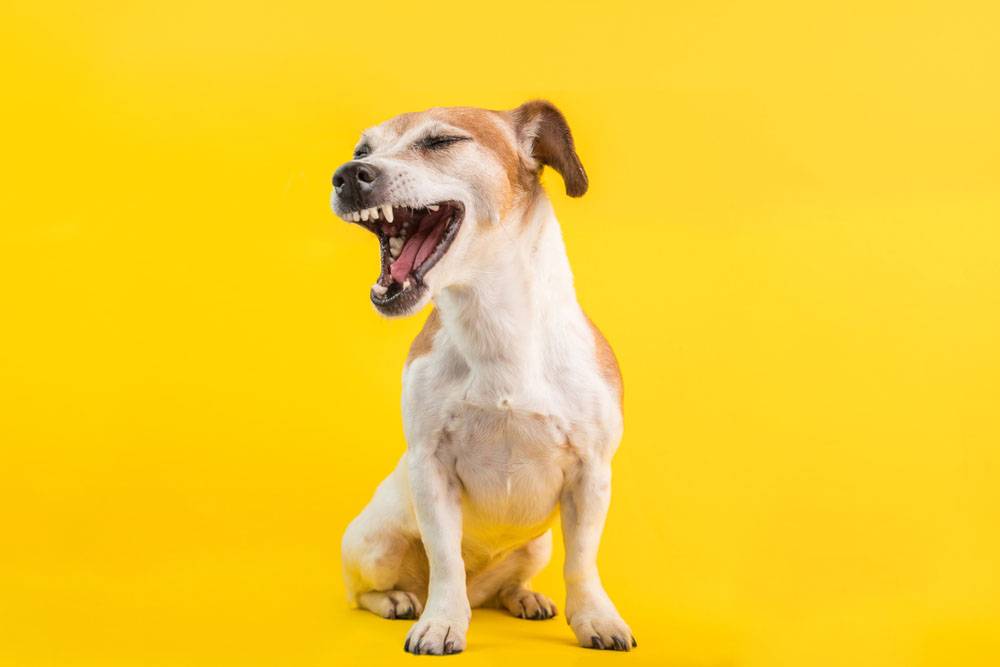
Contents
If the dog coughs – the main thing
Cough is a symptom of the underlying disease, which acts as a protective reflex to remove foreign particles from the surface of the respiratory system.
Cough looks like a sharp forced exhalation when the
glottisAnatomical part of the larynx.
The type of cough depends on the underlying disease and its localization.
The main causes of cough in dogs are: congenital pathologies of the upper respiratory tract (tracheal collapse,
BCSBrachycephalic Obstructive Syndrome), infections of various origins (bacteria, viruses, helminths, fungi), heart failure and oncology.
The main methods for diagnosing cough: examination by a veterinarian, X-ray diagnostics, blood tests, specific tests for pathogens, CT diagnostics, bronchoscopy with taking a washout from the lungs.
Treatment of cough depends on the underlying disease and its type. Usually prescribed: antibiotics, mucolytics or antitussive drugs, bronchodilators, inhalations, glucocorticosteroids. In certain cases (collapse, BCS), surgical treatment is indicated.
Prevention of cough comes down to annual vaccination, avoidance of hypothermia and passive smoking. Congenital pathologies cannot be prevented.
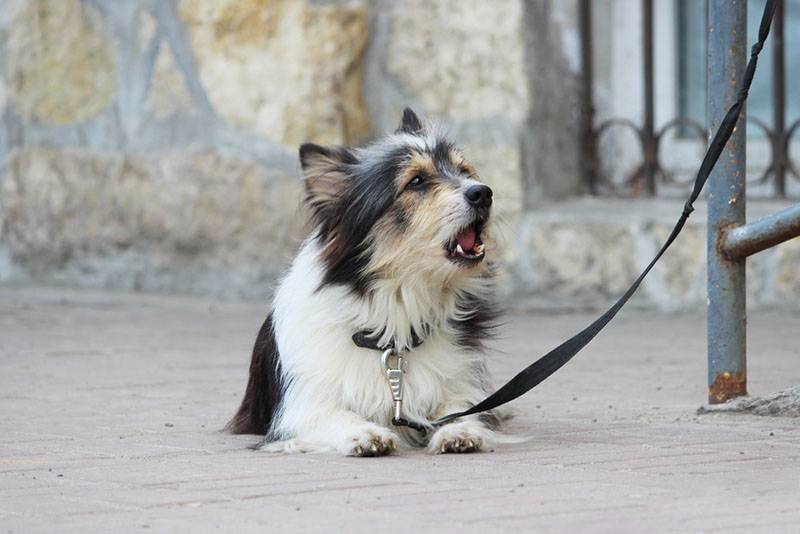
How does a dog cough?
Some people wonder – can dogs cough? Yes, a dog can cough. Visually, a cough looks like a sharp forced expiration with a closed glottis. It is a protective mechanism to remove secretions and foreign particles.
A cough is usually preceded by an inhalation followed by an exhalation. Often, in the process of a paroxysmal strong cough, the pet’s neck stretches and the body shudders.
Sometimes owners confuse cough with reverse sneezing syndrome. Reverse sneezing occurs when foreign particles enter the larynx and soft palate. It is possible that if you observe your pet coughing after eating, it is a reverse sneeze and not a cough. Reverse sneezing is a normal physiological process that does not require treatment if the syndrome rarely recurs. If a reverse sneeze doesn’t go away within a few days, your pet should see a veterinarian.
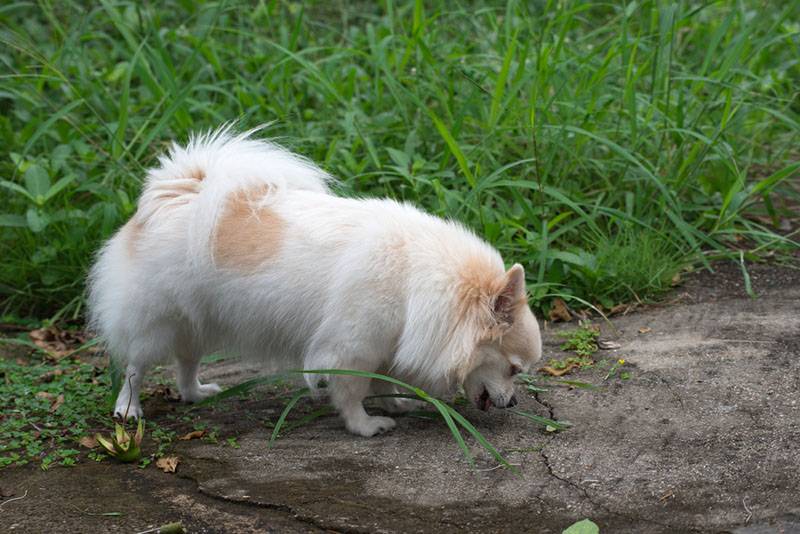
Types of cough in dogs
In order to understand and understand the types of cough, you need to remember what the respiratory system consists of. After all, the nature and type of the disease directly depends on where the cough reflex starts.
The respiratory system is divided into the upper respiratory tract (nasal cavity, larynx, part of the pharynx, trachea) and lower respiratory tract (bronchi and lungs).
Cough receptorsA group of nerve endings that perceive extraneous stimuli and convert them into a nerve impulse, upon stimulation of which a nerve impulse is generated that transmits information to the brain, are located in the larynx, trachea and large bronchi.
Cough is described as follows:
By productivity;
By frequency;
The nature;
With the flow.
Productivity means sputum production. Unproductive cough in a dog is dry, without discharge. A productive cough in a dog is wet, with sputum.
The frequency of cough is rare, periodic, frequent.
By nature – short, long, paroxysmal.
Downstream – acute, subacute, chronic.
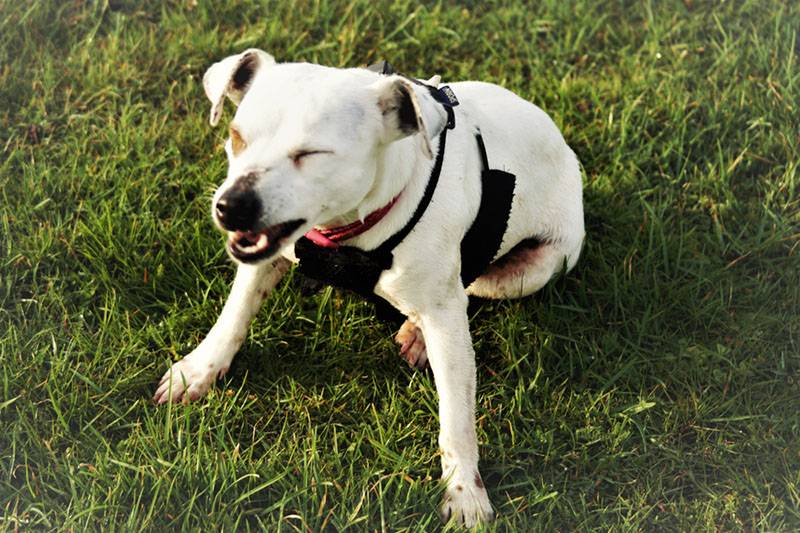
Why a dog coughs – 9 reasons
There can be many reasons. We will look at the most basic ones:
Pathologies of the upper respiratory tract due to a violation of the anatomical structure of organs – tracheal collapse, BCS;
Infections – bacterial, viral, helminthic, fungal;
Cardiac cough due to heart failure;
oncological process.
Collapse of the trachea
A common cause of cough in small breeds (York, Chihuahua, Pug) is the collapse of the trachea. Tracheal collapse is a narrowing of the tracheal tube in any part of it. The tracheal tube is made up of tracheal rings. During the collapse, part of the rings sags, forming a narrowing, which reduces the air permeability. Cough develops due to the fact that the tracheal rings rub against each other during narrowing and irritate the cough receptors.
Cough during collapse of the trachea may be on the background of emotional arousal, pulling on the leash and squeezing the collar of the trachea, due to the ingress of cold air. Also, the pet may begin to cough when drinking water. It can be both a short dry cough and paroxysmal. Sometimes owners compare such a cough with a goose cackle – this is a characteristic sign of a collapsed trachea.
Severe collapse may require surgical treatment.

BCS syndrome
BCS – a shortened facial part of the skull, which creates an obstacle to the inhaled air. This syndrome occurs in French and English Bulldogs, Pugs, Griffons, Shih Tzu, Pekingese, Boston Terriers, Spitz, Chihuahuas, Boxers.
It all starts harmlessly with narrowed nostrils, but in the future everything can end
bronchial collapseNarrowing of the lumen of the bronchi. The collapse of the bronchi is dangerous because the lung tissue ceases to function normally, and the animal suffocates from lack of oxygen.
Such patients make grunting sounds, cough heavily. Often, owners note bluish mucous membranes of the oral cavity.
Unfortunately, there is no effective medical treatment, and often it is necessary to resort to surgical treatment.
Bacterial infections
Bacteria, just like in humans, can cause
tracheitisInflammation of the trachea, bronchitisInflammation of the bronchi и bronchopneumoniaPneumonia in dogs. The main symptom of these diseases is cough. The most common pathogens are bacteria – staphylococci and streptococci.
A dog with a bacterial infection often coughs, sometimes even to the point of gagging. The gag reflex occurs with a strong cough, when the whole body shudders, and the vomiting receptors are irritated.
With bronchopneumonia, the pet coughs to hoarseness, the body temperature rises. The disease is accompanied by lethargy, apathy, heavy breathing and sputum production.
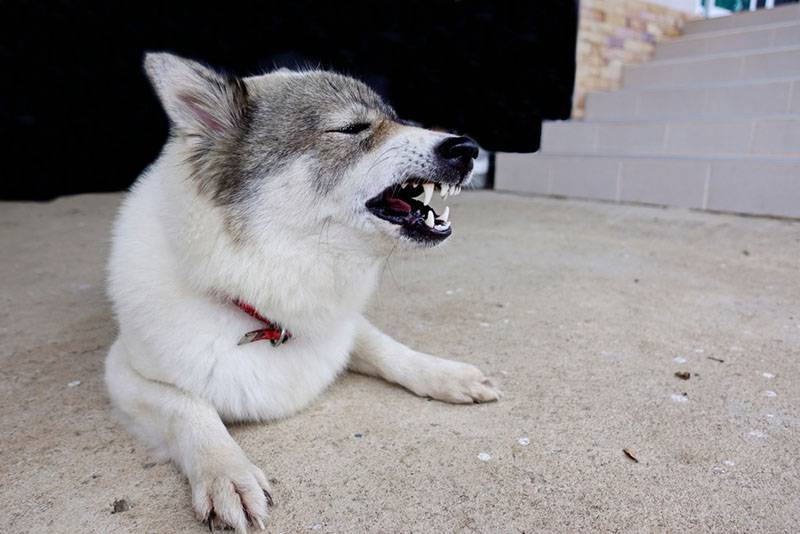
Viral infections
Many viral infections can also affect the respiratory system and cause coughing. The most common infections are: canine adenovirus type 2, canine respiratory coronavirus, canine influenza virus, canine herpesvirus, canine pneumovirus, canine parainfluenza virus. From some infections, you can protect the animal by complex vaccination against viral infections.
The cough begins acutely, with or without sneezing, and is also accompanied by mucous discharge from the nasal cavity. The nature of the cough is usually strong, paroxysmal. The dog cannot cough. With severe attacks, the pet coughs as if choking. There may also be a cough with a gag reflex. The state of the animal is accompanied by lethargy, apathy and often an increase in body temperature.
Helminth invasion
Some
helminth infestationsParasitic disease caused by parasitic worms may also be accompanied by coughing. This is due to the fact that when helminth eggs enter the intestine, the development of larval stages passes through the respiratory system, then goes back into the digestive tract. The pet seems to be spitting up something and the larvae are swallowed again with saliva into the stomach and intestines. Most often, these are pathogens. hookwormHelminthiasis caused by parasitic hookworms, toxocarosisHelminth invasion caused by helminths from the group of nematodes.
In the southern regions of Russia, the disease is very common
dirofilariasisParasitic disease caused by Dirofilaria immitis. Recently, cases of infection have also been recorded in the central regions of Russia. This is a helminth infestation that is transmitted by mosquito bites. One infected mosquito is enough to infect an animal. The localization of helminths is the pulmonary artery, which departs from the right ventricle of the heart to the lungs. Sometimes helminths can be seen with echocardiography of the heartUltrasound of the heart. Taking into account the fact that parasites live in the vessels of the lungs, their vital activity causes serious harm to the bronchi and lungs.
A dog with dirofillariasis constantly coughs, its breathing becomes heavy, the animal refuses to exercise. This disease is not transmitted to humans.
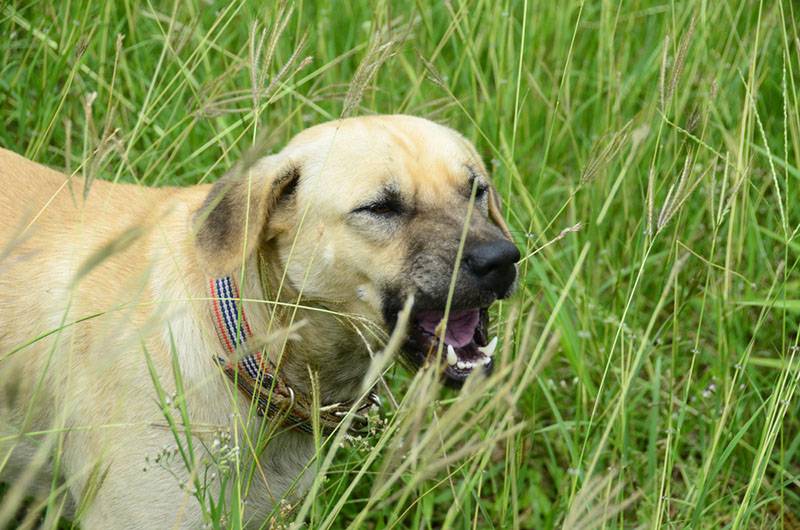
Heart cough
It is associated with heart failure. But you need to understand that a cough appears only when the chambers of the heart are greatly enlarged and compress the bronchi that are on top. There is no cough in the initial stages of heart failure.
Usually pets with heart disease cough after sleep. But with the development of cardiogenic
pulmonary edemaRelease of the liquid part of the blood into the alveoli of the lungs and filling the lungs with fluid the picture looks different – the dog is breathing heavily and coughing. In this case, the pet should immediately show the doctor.
Allergic reaction
An allergic reaction can also cause a cough. An allergy can be to the flowering of trees and plants in the season, household chemicals and perfumes. Foreign agents (pollen, particles of household chemicals), getting on the mucous membranes of the respiratory tract, cause an inflammatory reaction. Due to the development of an inflammatory reaction, the mechanism of cough and bronchospasm is triggered.
The dog can both quickly clear his throat and shake in attacks.
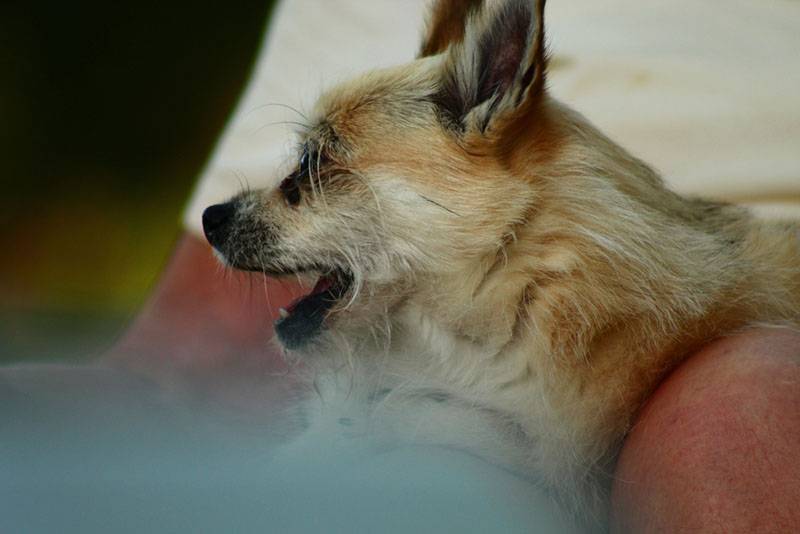
Fungal infections
In rare cases, a cough can be caused by a fungal infection. Everything can start with an infection of the upper respiratory tract, and end with damage to the bronchi and lungs with weak immunity or if an infection is triggered.
Here it is necessary to choose the right therapy and choose an antibiotic active against fungi.
Oncology
In older animals, the cause of coughing may be
oncological processFormation of malignant or benign tumors in the lungs. The lungs can be affected by both an independent tumor and metastatic processSecondary tumors that grow from cells in the primary tumorif the lesion is in another organ.
Often, the oncological process in the lungs is accompanied by the release and accumulation of fluid in the chest cavity – hydrothorax. Such patients breathe heavily and cough with wheezing. Unfortunately, if the respiratory system is affected by a tumor process, the prognosis is extremely unfavorable. You can use only symptomatic therapy aimed at facilitating the patient’s breathing.
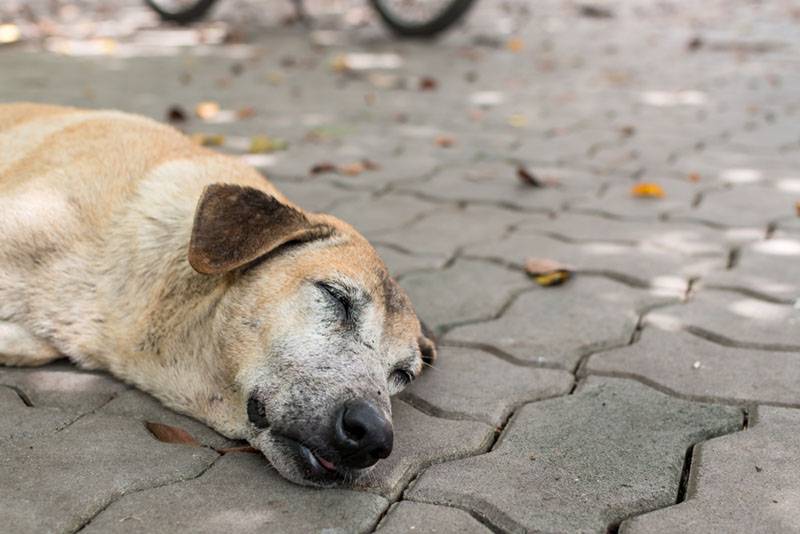
Diagnostics
Diagnosis begins with an appointment with a veterinarian. He examines the pet, checks
tracheal reflexSlight compression of the trachea, conducts auscultation of the chestListening to the chest with a phonendoscope, palpation and thermometry. With the help of auscultation, it is possible to identify the department of the respiratory system in order to understand the cause of the disease.
Also, do not forget about the analysis. A clinical blood test can show signs of an inflammatory process, anemia, helminthic and allergic reactions. A biochemical blood test is more needed to assess the condition of the liver and kidneys for prescribing antibiotics.
Specific analyzes (
PCRPolymerase chain reaction, ELISALinked immunosorbent assay, THEY DIDImmunochromatographic analysis) allow you to make an accurate diagnosis of viral and bacterial infections. They determine the pathogen by specific protein components of the blood.
When coughing, it is worthwhile to carry out an x-ray of the chest in two projections: direct and lateral.
This will determine the degree of damage to the organs of the respiratory system and make a diagnosis. Sometimes more complex additional diagnostics are required:
CT examinationComputed tomography, bronchoscopy with taking bronchoalveolar lavage.
A CT scan is considered more informative than an X-ray, since it allows a more detailed assessment of the nature and degree of damage to the pathological process. Also, this study is resorted to in controversial situations, when one x-ray is not enough to make a diagnosis, for example, with a collapse of the trachea or an assessment of the oncological process in the lungs.
Bronchoscopy with taking bronchoalveolar lavage is a diagnostic procedure that is performed by introducing a special video device (endoscope) and isotonic sodium chloride solution into the bronchi and lungs. Bronchoscopy allows you to assess the condition of the respiratory system from the inside. The solution is injected into the bronchi and lungs and then taken out. Subsequently, the wash is sent for analysis in order to understand the structure of the extracted cells and identify the causative agent of the disease. This procedure helps to make an accurate diagnosis, and knowledge of the pathogen allows you to choose a treatment.
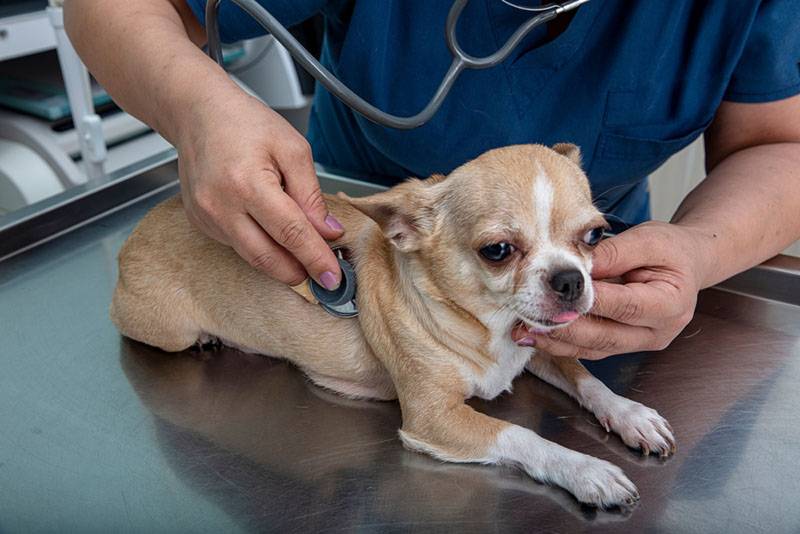
What to do if the dog coughs?
In this section, I will tell you in detail how and how to treat a dog for coughing.
With a dry character and a mild form of cough, antitussive preparations containing butamirate – Sinekod in drops, syrup and Omnitus tablets are sufficient. This substance blocks the cough center in the brain.
For bronchitis of an allergic nature, inhalations of Seretide 125 + 25 mcg (prevents bronchospasm and has an anti-inflammatory effect) or Flixotide 125 mcg (prevents bronchospasm) are used. The peculiarity of the use of inhalation in animals is the use
spacerDevice for inhalation – a special device where the active substance is concentrated, which the patient must inhale. You can also use inhalation with nebulizerDevice for inhalation.
Antibiotics are used when there is a bacterial infection. They are prescribed, as a rule, for 3-4 weeks and are canceled only under the supervision of the attending physician. Since with early cancellation, it is possible to grow a stable bacterial microflora and the drugs will no longer work. Usually, antibiotics in the tablet form of the amoxicillin series (Sinulox), the doxycycline series (Unidox Solutab, Ronaxan, Doxifin) or fluoroquinolones (Marfloxin) are used in combination with injections of cephalosporins (Ceftriaxone, Cefazolin).
As a cough medicine for dogs, expectorants are also used in the wet form – ACC syrup, Lazolvan.
In some cases, systemic glucocorticosteroids are used – Prednisolone, Dexamethasone. These are hormonal drugs that have anti-inflammatory effects due to the suppression of the immune system. But they are contraindicated in the presence of heart failure.
In severe cases of tracheal collapse or BCS, surgical treatment is indicated.
It is important to understand that if a pet’s cough does not go away within two to three days, this is a reason to see a veterinarian.
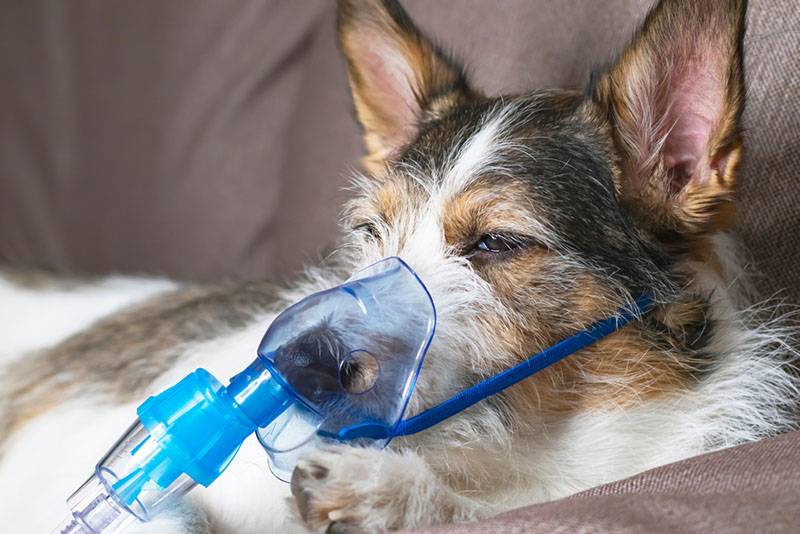
If the puppy is coughing
Why can a puppy cough? There can also be many reasons, but mostly these are viral or bacterial infections that are transmitted by airborne droplets. If you notice a cough in your puppy, you should immediately take him to the veterinarian. For a baby, this can be many times more dangerous than for an adult animal.
Also, babies have congenital heart defects, which give complications to the respiratory system and provoke the development of a cough.
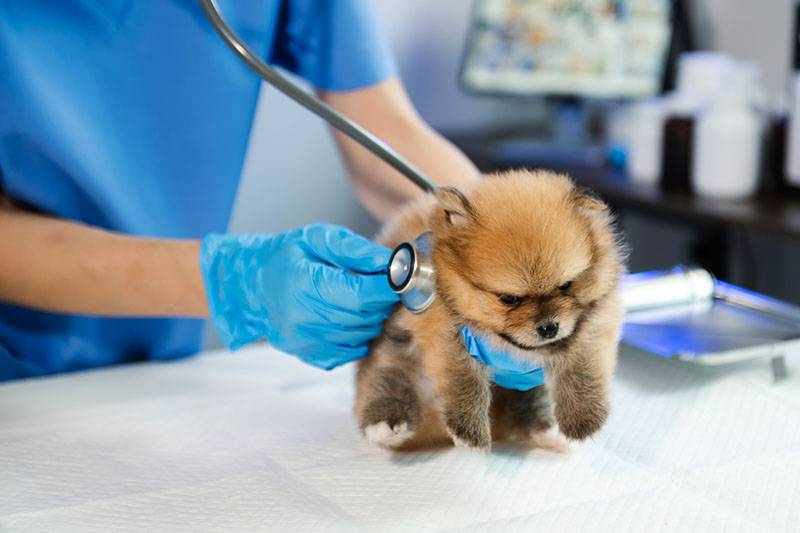
Prevention of cough in dogs
To prevent coughing in your pet, you must:
Conduct annual vaccination against major viral diseases;
Avoid hypothermia of the dog;
Do not smoke near your pet and avoid strong-smelling household chemicals and perfumes;
Avoid contact while walking with unfamiliar animals – you can become infected, since, unfortunately, there is never a guarantee that other owners will treat their pets in good faith.
Congenital pathology – collapse of the trachea and BCS – unfortunately, cannot be prevented.
With symptoms of coughing, without tightening, you need to take the pet to an appointment with a veterinarian.

summary table
Below is a summary table – cough in a dog: causes, symptoms, treatment.
Cause | Symptoms | Treatment |
Collapse of the trachea | Short or paroxysmal cough, without expectoration, sounding rough | Antitussive drugs Inhalation of glucocorticosteroids and bronchodilators using a spacer Antibiotics for secondary bacterial infection Systemic glucocorticosteroids Surgical treatment in severe cases of collapse |
BCS syndrome | Short or paroxysmal cough, without expectoration, sounding rough Bluish tinge of mucous membranes | Surgery Additional drugs to ease breathing |
Bacterial infection | Strong, prolonged, paroxysmal cough of a dry or wet nature, often with wheezing Fever Discharge from the nose Rapid breathing | Antibiotics Mucolytics Antipyretic Inhalation with a nebulizer |
Viral infection | Strong, prolonged, paroxysmal cough of a dry or wet nature, often with wheezing Fever Discharge from the nose Rapid breathing | Antitussives or mucolytics depending on the nature of the cough Antipyretic drugs Antibiotics for secondary bacterial infection Inhalation with a nebulizer |
Helminth invasion | Short or prolonged cough, as if the pet is spitting up something and swallowing, often dry | Anthelmintic therapy – Caniquantel With dirofilariasis – specific therapy with Immiticide with a preparatory stage of antibiotics for a month |
Heart cough | Rare, short or paroxysmal cough, usually dry | Antitussives + heart failure therapy |
Allergic reaction | Infrequent short or paroxysmal dry cough | Antihistamines Inhalation of glucocorticosteroids and bronchodilators using a spacer Systemic glucocorticosteroids |
Fungal infection | Strong, prolonged, paroxysmal cough of a dry or wet nature, often with wheezing Fever Rapid breathing | Antibiotics active against fungi Antitussives or mucolytics depending on the nature of the cough Antipyretic |
Oncology | Rare, short or paroxysmal cough with wheezing | Symptomatic drug therapy that facilitates breathing – inhalation, antibiotics for inflammation, systemic glucocorticosteroids |
Answers to frequently asked questions
Sources:
Ivanov V. P. “Veterinary clinical radiology”, 2014, 624 pages.



